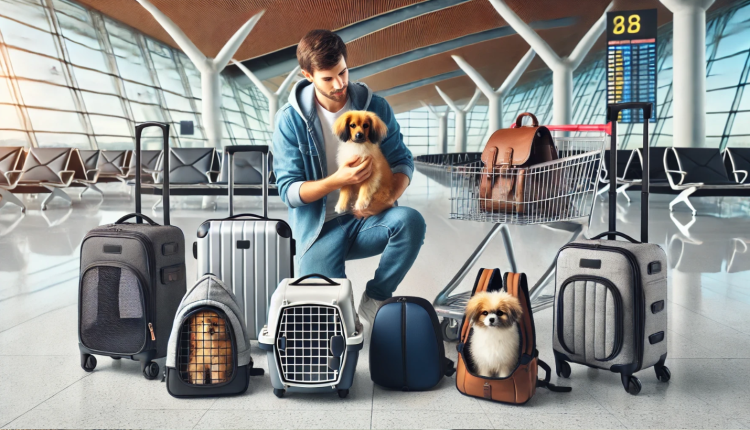Choosing the Right Pet Carrier for Stress-Free Travel
Traveling with pets requires careful planning to ensure their safety and comfort. A crucial aspect of this preparation is selecting an appropriate carrier. With various options available, understanding the features and benefits of each type can help you make an informed decision tailored to your pet’s needs.
Hard-Sided Carriers
Description: Hard-sided carriers are constructed from sturdy materials like plastic or metal, providing a rigid structure that offers robust protection.
Advantages:
- Durability: These carriers withstand impacts, making them suitable for air travel and long journeys.
- Easy Cleaning: The solid surfaces are simple to wipe down and sanitize.
- Security: Many models feature secure locking mechanisms to prevent escapes.
Considerations:
- Weight: They can be heavier and less portable than other options.
- Storage: Their rigid shape may require more storage space when not in use.
Hard-sided carriers are ideal for pets that require a secure environment during transit, especially for air travel where durability is paramount.
Soft-Sided Carriers
Description: Made from flexible materials like nylon or polyester, soft-sided carriers are lightweight and often feature mesh panels for ventilation.
Advantages:
- Portability: Their lightweight design makes them easy to carry.
- Flexibility: They can fit under airplane seats, adhering to many airline regulations for in-cabin travel.
- Comfort: Soft materials and mesh panels provide a cozy environment with ample airflow.
Considerations:
- Durability: Less resistant to chewing or scratching; not suitable for pets prone to such behaviors.
- Support: May lack the structural support needed for larger or heavier pets.
Soft-sided carriers are well-suited for small to medium-sized pets and are a popular choice for in-cabin air travel due to their flexibility and comfort.
Backpack Carriers
Description: Designed like a backpack, these carriers allow you to carry your pet on your back, keeping your hands free.
Advantages:
- Hands-Free Convenience: Ideal for navigating crowded areas or engaging in activities like hiking.
- Close Contact: Keeps pets close to your body, which can be comforting for anxious animals.
- Ventilation: Many models include mesh panels for airflow.
Considerations:
- Weight Distribution: Can become uncomfortable if carrying heavier pets for extended periods.
- Size Limitations: Generally suitable for smaller pets due to weight constraints.
Backpack carriers are excellent for pet owners who enjoy outdoor activities and want to keep their small pets close during excursions.
Sling Carriers
Description: Sling carriers are fabric pouches worn across the body, allowing pets to rest comfortably against the owner’s side or chest.
Advantages:
- Ease of Access: Pets can be easily placed in and taken out of the sling.
- Bonding: Promotes close physical contact, which can soothe nervous pets.
- Portability: Lightweight and easy to fold when not in use.
Considerations:
- Support: Offers less structural support, making them unsuitable for longer journeys.
- Size Restrictions: Best for very small pets due to limited space and support.
Sling carriers are perfect for short trips or errands, providing a cozy spot for tiny pets to accompany their owners.
Wheeled Carriers
Description: These carriers come equipped with wheels and a telescoping handle, similar to rolling luggage.
Advantages:
- Ease of Transport: Reduces the physical strain of carrying, especially for heavier pets.
- Stability: Provides a smooth ride on flat surfaces, minimizing jostling for the pet.
Considerations:
- Maneuverability: Less practical on uneven terrains or stairs.
- Size and Weight: Can be bulkier and heavier than other carrier types.
Wheeled carriers are suitable for urban environments and travel through airports, offering a convenient way to transport pets without carrying them.
Expandable Carriers
Description: These carriers feature zip-out sections that can be expanded to provide additional space when stationary.
Advantages:
- Versatility: Can be compact during travel and expanded to give pets more room to move.
- Comfort: Extra space allows pets to stretch and change positions, enhancing comfort during layovers or waiting periods.
Considerations:
- Complexity: Additional features may add to the carrier’s weight and setup time.
- Durability: Expansion panels may be less sturdy than the main structure.
Expandable carriers are ideal for travelers who want to provide their pets with extra space during breaks in the journey.
Airline Compliance
When selecting a carrier for air travel, it’s essential to ensure it meets airline specifications. Many airlines have specific size and design requirements for in-cabin pet carriers. Soft-sided carriers are often preferred for their flexibility to fit under seats. Brands like Sherpa offer models that adhere to these standards and participate in programs like “Guaranteed On Board,” ensuring compliance with airline policies.
Safety and Comfort Features
Regardless of the carrier type, certain features enhance safety and comfort:
- Ventilation: Adequate airflow is crucial; look for carriers with multiple mesh panels.
- Secure Closures: Zippers and locks should be sturdy to prevent accidental openings.
- Padding: Interior padding provides comfort; removable and washable liners are practical.
- Visibility: Some pets prefer to see their surroundings, while others may feel calmer with limited visibility; choose accordingly.
Acclimating Your Pet to the Carrier
Introducing your pet to the carrier before travel can reduce anxiety:
- Familiarization: Place the carrier in your home with the door open, allowing your pet to explore it voluntarily.
- Positive Reinforcement: Encourage use by placing treats, toys, or bedding inside.
- Short Trips: Start with brief car rides to help your pet associate the carrier with positive experiences.
Choosing the right carrier involves considering your pet’s size, temperament, and the nature of your travels. By evaluating the various types of carriers and their features, you can select one that ensures your pet’s safety and comfort, leading to more enjoyable journeys for both of you.

